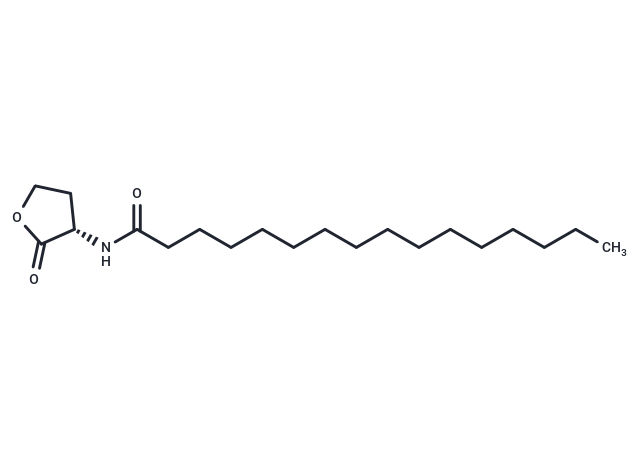Powder: -20°C for 3 years | In solvent: -80°C for 1 year
Quorum sensing is a regulatory system used by bacteria for controlling gene expression in response to increasing cell density.[1] This regulatory process manifests itself with a variety of phenotypes including biofilm formation and virulence factor production.[2] Coordinated gene expression is achieved by the production, release, and detection of small diffusible signal molecules called autoinducers. The N-acylated homoserine lactones (AHLs) comprise one such class of autoinducers, each of which generally consists of a fatty acid coupled with homoserine lactone (HSL). Regulation of bacterial quorum sensing signaling systems to inhibit pathogenesis represents a new approach to antimicrobial therapy in the treatment of infectious diseases.[3] AHLs vary in acyl group length (C4-C18), in the substitution of C3 (hydrogen, hydroxyl, or oxo group), and in the presence or absence of one or more carbon-carbon double bonds in the fatty acid chain. These differences confer signal specificity through the affinity of transcriptional regulators of the LuxR family.[4] C16-HSL is one of a number of lipophilic, long acyl side-chain bearing AHLs, including its monounsaturated analog C16:1-(L)-HSL, produced by the LuxI AHL synthase homolog SinI involved in quorum-sensing signaling in S. meliloti, a nitrogen-fixing bacterial symbiont of certain legumes.[5],[6] C16-HSL is the most abundant AHL produced by the proteobacterium R. capsulatus and activates genetic exchange between R. capsulatus cells.[7] N-Hexadecanoyl-L-homoserine lactone and other hydrophobic AHLs tend to localize in relatively lipophilic cellular environments of bacteria and cannot diffuse freely through the cell membrane. The long-chain N-acylhomoserine lactones may be exported from cells by efflux pumps or may be transported between communicating cells by way of extracellular outer membrane vesicles.[8],[9]

| パッケージサイズ | 在庫状況 | 単価(税別) |
|---|---|---|
| 5 mg | 約 35 days | ¥ 22,000 |
| 10 mg | 約 35 days | ¥ 41,000 |
| 50 mg | 約 35 days | ¥ 167,500 |
| 説明 | Quorum sensing is a regulatory system used by bacteria for controlling gene expression in response to increasing cell density.[1] This regulatory process manifests itself with a variety of phenotypes including biofilm formation and virulence factor production.[2] Coordinated gene expression is achieved by the production, release, and detection of small diffusible signal molecules called autoinducers. The N-acylated homoserine lactones (AHLs) comprise one such class of autoinducers, each of which generally consists of a fatty acid coupled with homoserine lactone (HSL). Regulation of bacterial quorum sensing signaling systems to inhibit pathogenesis represents a new approach to antimicrobial therapy in the treatment of infectious diseases.[3] AHLs vary in acyl group length (C4-C18), in the substitution of C3 (hydrogen, hydroxyl, or oxo group), and in the presence or absence of one or more carbon-carbon double bonds in the fatty acid chain. These differences confer signal specificity through the affinity of transcriptional regulators of the LuxR family.[4] C16-HSL is one of a number of lipophilic, long acyl side-chain bearing AHLs, including its monounsaturated analog C16:1-(L)-HSL, produced by the LuxI AHL synthase homolog SinI involved in quorum-sensing signaling in S. meliloti, a nitrogen-fixing bacterial symbiont of certain legumes.[5],[6] C16-HSL is the most abundant AHL produced by the proteobacterium R. capsulatus and activates genetic exchange between R. capsulatus cells.[7] N-Hexadecanoyl-L-homoserine lactone and other hydrophobic AHLs tend to localize in relatively lipophilic cellular environments of bacteria and cannot diffuse freely through the cell membrane. The long-chain N-acylhomoserine lactones may be exported from cells by efflux pumps or may be transported between communicating cells by way of extracellular outer membrane vesicles.[8],[9] |
| 別名 | C16-HSL, N-palmitoyl-L-Homoserine, N-hexadecanoyl-L-Homoserine lactone |
| 分子量 | 339.51 |
| 分子式 | C20H37NO3 |
| CAS No. | 87206-01-7 |
Powder: -20°C for 3 years | In solvent: -80°C for 1 year
Chloroform: 1 mg/mL
You can also refer to dose conversion for different animals. 詳細
bottom
Please see Inhibitor Handling Instructions for more frequently ask questions. Topics include: how to prepare stock solutions, how to store products, and cautions on cell-based assays & animal experiments, etc.
N-hexadecanoyl-L-Homoserine lactone 87206-01-7 C16-HSL N hexadecanoyl L Homoserine lactone NhexadecanoylLHomoserine lactone N-palmitoyl-L-Homoserine Inhibitor inhibitor inhibit
